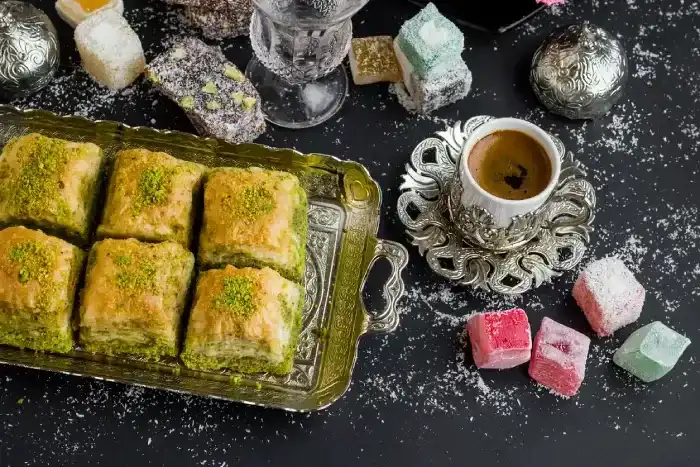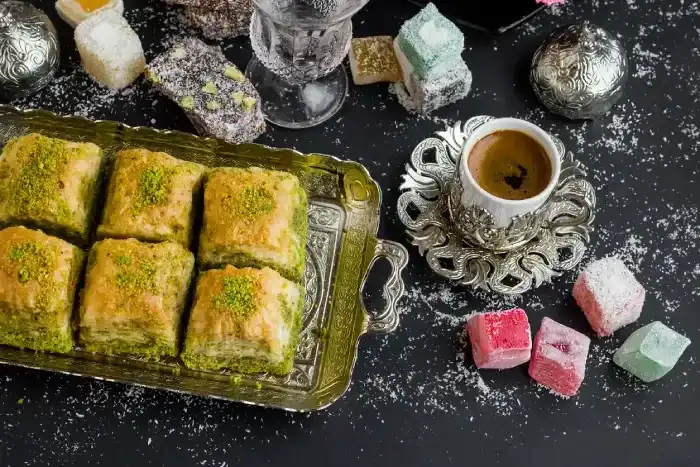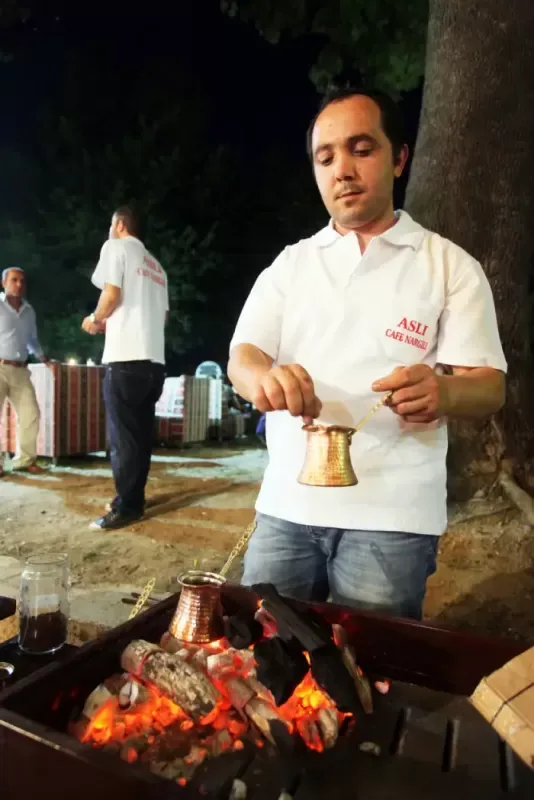Turkish Coffee History: Ancient Secrets Behind The World's Most Cherished Brew

Turkish coffee history began with a revolutionary moment in 1554 when the first coffeehouse opened its doors in Istanbul, forever changing how people gathered and socialized. This distinctive brew, prepared in a special pot called a cezve, stands apart from other coffee styles because it uses extremely fine grounds that remain in the cup when served, creating a rich, unfiltered experience that has endured for centuries.
The origin of Turkish coffee traces back to Yemen, where the coffee tree was first commercially cultivated before the Ottoman Empire controlled the region from 1538 to 1636. During this period, coffee drinking spread throughout the Islamic world, eventually earning such cultural significance that UNESCO added Turkish coffee culture to its Representative List of the Intangible Cultural Heritage of Humanity.
When you enjoy Turkish coffee today, you're participating in a tradition that involves specific preparation techniques - from achieving the perfect particle size between 75-125 microns to creating that signature thick layer of froth. Traditionally served in small porcelain cups called kahve fincanı alongside a glass of water, Turkish coffee often comes with something sweet like Turkish delight, with varying levels of sweetness based on your preference.

Seize the moment—Turkey’s wonders won’t wait! Book your Turkey Travel Packages now and make memories that last a lifetime!
A Brew Born of Empire: The Origin of Turkish Coffee
The journey of coffee to become the beloved Turkish brew began long before it reached Ottoman lands. Originally discovered in Ethiopia, coffee plants made their voyage northward to Yemen, where they were first commercially cultivated. This fertile region became the foundation for what would later evolve into one of the world's most distinctive coffee traditions.
From Yemen to Istanbul
For nearly a century (1538-1636), the Ottoman Empire maintained strategic control over Yemen's southern coastal region, including the renowned coffee port of Mocha. Throughout this period, Yemen held a virtual monopoly on coffee exports, with merchants deliberately preventing beans from germinating elsewhere to protect their trade advantage.
Two competing narratives explain how this precious commodity reached Istanbul. According to one account, Özdemir Pasha, the Ottoman Governor of Yemen, introduced coffee to Sultan Suleiman the Magnificent's court around 1521. Recognizing its value, the Sultan allegedly issued a royal decree adopting the beverage, thus initiating its spread throughout the empire.
The second, more widely accepted story credits Syrian merchants with bringing coffee culture to the Ottoman capital. Historical records confirm coffee was already in use in Istanbul by 1539, as evidenced by legal documents mentioning a "coffee chamber" in Ottoman admiral Barbaros Hayreddin Pasha's residence.
The pivotal moment came when two Syrian traders—Hakam from Aleppo and Shams from Damascus—opened the first coffeehouse in Istanbul's Tahtakale district in 1554. This establishment marked the beginning of a social phenomenon that would transform Ottoman society. Within decades, coffee culture exploded across the empire, with over 600 coffeehouses operating during Sultan Murad III's reign, not only in Istanbul but throughout Anatolia and beyond.
How the Ottomans shaped the brewing method
The Ottomans didn't merely adopt coffee—they reinvented it. While coffee had been consumed in various forms for centuries, the Ottoman brewing method created what we now recognize as Turkish coffee. They developed a distinct technique: roasting beans over fire, grinding them to a fine powder, and gently boiling them in water in a special pot called a cezve.
This methodical preparation became an art form. At the Ottoman court, the position of Chief Coffee Maker (kahvecibaşı) was established, selected for both loyalty and discretion. This prestigious role sometimes served as a stepping stone to higher positions, with Ottoman historical records noting several Chief Coffee Makers who later rose to become Grand Viziers.
The preparation method was as important as the beverage itself. Ottoman elites kept specialist coffee cooks, and Sultan Süleyman himself had a kahvecibasi (chief coffee-cook). The slow, deliberate brewing process extracted maximum flavor, creating a rich, unfiltered experience meant to be savored slowly while encouraging conversation.
From the imperial palace, coffee culture spread to grand mansions and eventually to ordinary homes. People purchased green coffee beans, roasting them on pans at home, then grinding them in mortars before brewing in their cezve. This meticulous preparation process became integral to Turkish domestic and social life.
The Ottoman coffee tradition transcended mere consumption. It became a sophisticated cultural ritual with specific cups, serving customs, and accompanying treats. Coffee was typically served in small cups, sometimes decorated with precious stones for elite settings, alongside sweets like Turkish delight. This combination of flavor, ritual, and social context created a unique coffee experience that would eventually influence coffee cultures worldwide.

Customize Your Dream Vacation!
Get in touch with our local experts for an unforgettable journey.
Plan Your Trip
The Coffeehouse Revolution: Social Life and Politics
Ottoman coffeehouses fundamentally reshaped social interactions across the empire, creating unprecedented spaces for civic engagement. Following their mid-sixteenth-century introduction, these establishments rapidly multiplied, with nearly 2,500 coffeehouses in Istanbul alone by the nineteenth century. Previously, social interactions were limited to homes, mosques, and shops; coffeehouses introduced an entirely new dimension to public life.
Coffeehouses as centers of discussion
These vibrant establishments emerged as the "Fourth Place," offering a neutral meeting ground with remarkable social leveling. French traveler Jean de Thévenot noted how men of all occupations, religions, and social standings freely mingled in these spaces. This revolutionary mingling allowed artisans to sit alongside merchants and soldiers, creating networks that transcended traditional social boundaries.
Coffeehouses specifically thrived as information hubs in an era without mass communication. Here, patrons exchanged updates on cabinet changes, corruption scandals, and potential wars. More importantly, these establishments facilitated critical political discourse, as noted by historian Hattox: "Coffeehouses were particularly significant for marginalized groups, including artisans, merchants, and soldiers, who found in them a space to voice their concerns".
Government bans and public resistance
Ottoman authorities quickly recognized the political threat posed by coffeehouses. Sultan Murad IV famously issued a "coffee ban" in 1633, prohibiting coffee consumption in public places. Particularly ruthless in his enforcement, he would reportedly travel through Istanbul in disguise, personally executing violators with his sword.
Nevertheless, these bans often achieved the opposite effect, increasing coffeehouses' symbolic importance as spaces of resistance. Despite numerous attempts to suppress them, coffee establishments demonstrated remarkable resilience. After Murad IV's death, his successors continued the ban, yet implementation grew increasingly lenient. By the mid-seventeenth century, underground coffee culture flourished throughout the empire.
The Janissaries—an elite military faction—particularly embraced coffeehouse culture. They established their own establishments marked with their insignia and used these spaces to organize resistance against absolutist policies. Historian Beeley notes that "Janissary-owned coffeehouses became centers of opposition where plans for coups and mutinies were hatched".
Coffee and literature, games, and art
Beyond politics, coffeehouses nurtured rich cultural expression. Patrons engaged in various entertainments, including:
- Shadow puppet performances and storytelling sessions
- Improvisational performances and satirical plays about everyday life
- Traditional board games like Turkish Rummikub (similar to Mahjong) and backgammon
The unique atmosphere of coffeehouses fostered artistic innovation unlike formal institutions such as courts or madrasas. Artists and performers benefited from immediate audience feedback and collective energy, allowing new forms to emerge and genres to blend.
Coffee itself became woven into cultural traditions beyond mere consumption. It served as a medium for reconciliation—when two men quarreled in a village, they would be served "friendship coffee" to open dialog and end resentment. As a Turkish saying suggests, coffee provided a pretext to initiate conversation across social divides.
By the eighteenth century, although government surveillance continued, coffeehouses had firmly established themselves as essential to Ottoman urban life. Their legacy extends into modern Turkish culture, where traditional kahvehanes still operate as community hubs for conversation, games, and, of course, the consumption of perfectly brewed Turkish coffee.
Secrets of the Perfect Cup: Brewing and Serving
Creating the perfect Turkish coffee requires precise attention to several critical elements that have remained unchanged for centuries. Each step carries cultural significance beyond mere preparation, from selecting the right beans to achieving that coveted layer of foam.
Choosing the right grind and roast
The foundation of authentic Turkish coffee begins with properly selected and processed beans. Traditionally, medium to dark roast Arabica beans are preferred for their sweet, delicate taste and reduced acidity, allowing chocolate and nutty notes to emerge fully during brewing. However, the most distinctive characteristic is the grind—Turkish coffee demands an ultra-fine consistency, even finer than espresso, resembling powdered sugar or flour. This extremely fine texture, comparable to 75-125 microns, enables the full extraction of flavors and contributes to the characteristic thickness.
The cezve and brewing process
At the heart of preparation sits the cezve (also called ibrik)—a small, long-handled pot with a wide bottom, narrow neck, and distinctive pouring lip. This unique shape is specifically designed to create the rich foam that defines properly prepared Turkish coffee.
The brewing process itself takes merely two minutes but requires attention to detail:
- Begin with cold water measured in the serving cup
- Add one heaping teaspoon (approximately 6g) of coffee per cup
- Add sugar now if desired (never after brewing)
- Heat slowly over low to medium heat, stirring initially
- As foam begins to rise, remove from the heat
- Pour some foam into each cup first
- Return to the heat until it nearly boils again
- Pour the remaining coffee into cups
Foam, sugar, and flavor balance
The köpük (foam) crowning Turkish coffee serves as the hallmark of proper preparation. This light, frothy layer should be evenly distributed without large bubbles, indicating careful brewing technique. More than decorative, the foam contributes a silky, velvety mouthfeel and enhances the overall richness of the experience.
Sugar, furthermore, plays a crucial role in flavor development. In Turkish tradition, four distinct sweetness levels exist:
- Sade: No sugar
- Az şekerli: Little sugar (one teaspoon)
- Orta: Medium sweet (two teaspoons)
- Şekerli: Sweet (three teaspoons)
Serving etiquette and customs
Proper serving reflects the deep hospitality embedded in Turkish coffee culture. The coffee is customarily accompanied by a glass of cold water to cleanse the palate before sipping. Traditionally, it's served in small porcelain cups called fincan, often with something sweet like Turkish delight.
Traditions That Brew Beyond the Cup
Beyond mere consumption, Turkish coffee has woven itself into the cultural fabric of society, becoming a central element in significant life events and social interactions.
Important to realize, proper etiquette dictates serving the eldest person first as a sign of respect. Additionally, coffee should be served with sufficient foam distributed equally among all cups, as this demonstrates the host's skill and consideration for guests.

Wedding rituals and salted coffee
Throughout Turkish history, coffee has played a pivotal role in marriage ceremonies. The traditional "kız isteme" (asking for the girl's hand) involves the prospective groom's family visiting the bride's home, where the bride-to-be prepares and serves Turkish coffee. Notably, a fascinating custom emerges at this moment - the bride serves the groom a coffee deliberately prepared with salt instead of sugar.
This salty brew serves as both a symbolic gesture and a character test. As the groom sips this intentionally unpalatable drink without complaint, he demonstrates his patience and good temperament. In essence, this ritual acknowledges that marriage, like the coffee, isn't always sweet. The groom who drinks the coffee without grimacing proves his capacity to handle life's inevitable difficulties.
Fortune-telling and storytelling
After enjoying Turkish coffee, a separate tradition begins - reading the coffee grounds left in the cup. This practice, known as tasseography, starts when you finish your coffee, place the saucer atop your cup, make a wish, and turn it upside down.
Once the grounds cool and settle, patterns form inside the cup. These patterns become the medium through which futures are predicted or stories are told. In Jordan and other regions, the dried grounds inspire creative storytelling, with images resembling camels, mountains, or stars becoming elements in tales told especially to children.
The art of reading coffee grounds spread from Turkey to Europe in the late 17th century, becoming fashionable first in Paris before reaching Austria, Hungary, and Germany. In fact, among friends, it remains an inseparable part of the coffee experience, with the reader examining symbols to impart good news and foster positive outlooks.
Coffee as a gesture of peace
In Anatolian tradition, whenever two individuals quarreled, "friendship coffee" would be served to resolve disputes. Coffee functioned as a social lubricant - a pretext to initiate conversation across social divides and mend broken relationships. The act of accepting a cup of coffee from someone is considered a source of pride for the person offering it, illustrated in common expressions like "his coffee can be drunk" and "I would drink a cup of your coffee."
From Local Ritual to Global Icon
What began as a local Ottoman beverage grew into a global cultural phenomenon, spreading well beyond the borders of its imperial origins to influence coffee cultures worldwide.
Spread to Europe and cultural adaptations
The Ottomans inadvertently introduced Europe to coffee through multiple channels. In 1669, the Turkish Ambassador formally presented coffee to the Parisian court of Louis XIV, launching its French popularity. The first French coffee shop, Café Procope, opened in 1689. Interestingly, Vienna's coffee story carries more drama – after the failed Ottoman siege in 1683, abandoned sacks of coffee beans were discovered. A Polish hero named Franz Kolschitzky recognized their value and opened Vienna's first coffeehouse, wisely adapting the drink by adding cream and honey to suit local tastes.
Throughout Europe, coffee initially faced resistance as an acquired taste. Europeans transformed the strong, bitter Turkish preparation by diluting it with water or milk and adding sugar. As one historian noted, "Combining coffee with fresh milk turned a Turkish drink into a French one." Yet merchants strategically promoted the "Turkish" connection, capitalizing on the exotic appeal that helped the new drink sell.
Modern resurgence and third-wave coffee
After centuries of cultural significance, Turkish coffee faced challenges during the 20th century. Wartime shortages and economic hardships meant coffee was sometimes unavailable or adulterated with chickpeas. Consequently, tea consumption surpassed coffee in Turkey.
Recently, a remarkable revival has occurred. Alongside tradition, "third-wave coffee" has reached Istanbul, focusing on artisanal quality and innovative techniques. By 2018, over 400 Starbucks stores operated in Istanbul alone, with younger Turks embracing contemporary coffee culture. Yet experts remain confident that traditional Turkish coffee will persist. "Turkish coffee is not in danger of extinction. On the contrary, it is getting very popular, especially among young people," notes coffee specialist Osman Serim.
UNESCO heritage and cultural pride
In recognition of its cultural significance, UNESCO inscribed Turkish coffee culture on the Intangible Cultural Heritage List in 2013. This acknowledgment celebrates not just the brewing method but the rich communal traditions surrounding coffee consumption. Since then, December 5th is annually celebrated as World Turkish Coffee Day with events promoting this heritage globally.
The UNESCO designation recognizes coffee's role as "a symbol of hospitality, friendship, refinement, and entertainment that permeates all walks of life" in Turkish society. This ancient tradition continues thriving centuries after its origin, maintaining its place as both a cultural ambassador and a daily ritual.
Turkish coffee stands as more than just a beverage – it represents centuries of tradition, social connection, and cultural identity. Throughout history, this distinctive brew has transformed from a simple Yemeni import into a cornerstone of Ottoman society and eventually a globally recognized cultural treasure.

The journey began in Yemen before flourishing under Ottoman influence, where the meticulous brewing method using the cezve and ultra-fine grounds created a unique coffee experience unlike any other. Coffee's influence extended far beyond taste, nonetheless. Coffeehouses revolutionized social structures, creating spaces where people from different backgrounds could gather, exchange ideas, and occasionally challenge authority despite government attempts to suppress them.
Turkish coffee rituals remain deeply embedded in significant life moments. Wedding ceremonies still feature the symbolic salted coffee test, while fortune-telling through coffee grounds continues to bring friends together in shared moments of storytelling and prediction. These traditions emphasize how coffee serves as both a daily pleasure and a vehicle for meaningful human connection.
The global spread of Turkish coffee demonstrates its remarkable adaptability. European countries embraced this exotic drink while adapting it to local tastes, creating entirely new coffee cultures as a result. Though modern coffee trends have emerged, Turkish coffee persists, earning UNESCO recognition as Intangible Cultural Heritage and affirming its enduring significance.
Next time you savor a cup of Turkish coffee, remember you're participating in a tradition that spans centuries – one that has shaped societies, fostered relationships, and created spaces for both everyday conversations and world-changing ideas. This unfiltered, rich experience connects you directly to generations of coffee lovers who found meaning and community through the same distinctive brew.
FAQs
Q1. What makes Turkish coffee unique?
Turkish coffee is distinguished by its ultra-fine grind, special brewing method using a cezve, and the presence of grounds in the cup. It's known for its strong flavor, rich aroma, and the thick layer of foam on top, which is considered a hallmark of properly prepared Turkish coffee.
Q2. How did Turkish coffee spread to Europe?
Turkish coffee was introduced to Europe through various channels, including diplomatic missions and trade. The Ottoman siege of Vienna in 1683 played a significant role, as abandoned coffee beans led to the opening of Vienna's first coffeehouse. Europeans adapted the drink to local tastes, often adding milk or cream.
Q3. What is the significance of Turkish coffee in social traditions?
Turkish coffee plays a central role in many social traditions, including wedding ceremonies, where the bride serves the groom coffee with salt as a test of character. It's also used in fortune-telling practices and as a means of resolving disputes between individuals.
Q4. How is Turkish coffee prepared?
Turkish coffee is prepared by combining finely ground coffee, cold water, and optional sugar in a special pot called a cezve. It's heated slowly, allowing foam to develop, then briefly removed from the heat before being returned to nearly boil again. The resulting brew, including grounds, is served in small cups with the foam on top.
Q5. Why was Turkish coffee recognized by UNESCO?
UNESCO inscribed Turkish coffee culture on the Intangible Cultural Heritage List in 2013, recognizing not just the brewing method but the rich communal traditions surrounding coffee consumption. It acknowledges coffee's role as a symbol of hospitality, friendship, and entertainment in Turkish society.
Related Articles
Keep the inspiration going with these handpicked travel reads.
